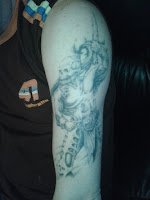http://en.wikipedia.org/wiki/History_of_tattooing
History of tattooing - Culture.
China
In ancient China, tattoos had been associated with criminals and bandits since at least the Zhou Dynasty (1045 BC to 256 BC). Tattooing Chinese characters such as "Prisoner" on convicted criminals' or slaves' faces was practiced until the last dynasty, the Qing Dynasty (1644 to 1912).
However, tattoos can be found to have been referenced in popular culture. Tattoos are present in one of the Four Great Classic Novels in Chinese literature, Water Margin, in which at least three of the main characters, Lu Zhishen, Shi Jin and Yan Ching are described as having tattoos covering nearly all of their bodies. Wu Song was sentenced to tattoo his face with his crime after having killed Xi Menqing to avenge his brother. In addition, Chinese legend has it that the mother of Yue Fei, a famous general of the Song Dynasty, tattooed the words "Jing Zhong Bao Guo" on his back with her sewing needle before he left to join the army, reminding him to "repay his country with pure loyalty".
Marco Polo wrote of Quanzhou "Many come hither from Upper India to have their bodies painted with the needle in the way we have elsewhere described, there being many adepts at this craft in the city."
Egypt and India
In northern India, permanent tattoos are called ""Godna."" Tattoos have been used as cultural symbols among many tribal populations, as well as the caste-based Hindu population of India. Henna and Mehndi were popular in ancient India and ancient Egypt, and still remain popular today in the Indian subcontinent, Middle East and North Africa.
Tattooing in the 21st century
During the latter decades of the 20th century tattooing became a popular social practice worldwide. Many younger (and some older) people today either have aspirations to have a tattoo somewhere on their body, or already have one or more. Some elect for one or several small tattoos such as butterflies, flowers, or other designs, while others may have significant portions of their skin covered. Popular along these lines are the 'half-sleeve', having the upper arm covered in tattoos, or 'full-sleeve', which includes the upper and lower arms.
Whether or not to get a tattoo which is visible while wearing clothing is a matter of taste, but also involves consideration of future employment opportunities, and societal and family pressures.
It is assumed that the majority of tattoo recipients patronize tattoo parlors, which- according to varying state laws- have been registered and observe accepted standards of hygiene. However, some individuals do not, and some even use home tattooing equipment.
Over the past 50–100 years, it has become more acceptable for ordinary people to have tattoos and less so for the aristocracy - a reversal of the situation in the 19th and early 20th centuries. Tattoos are also used today as a sign of affiliation to certain street gangs and many are tattooed in prison as 'badge of honor' so that 'ex-cons' can recognize each other. Tattooing has also gained more popularity with women in recent years. Bodies of Subversion: A Secret History of Women and Tattoo, by Margot Mifflin, became the first history of women's tattoo art when it was released in 1997. In 2012, tattooed women outnumbered men for the first time in American history - according to a Harris poll, 23% of women in America had tattoos in that year, compared to 19% of men.
Tattooing remains as the archetypal means of 'body painting' and decoration, and certainly the most permanent, and while the traditional popular designs appear to have been devised from 'heavy metal' and 'motorbike gang culture, these are slowly being replaced by more modern tattoo designs based upon Celtic, Indian and Asian themes in addition to floral and other natural images.










